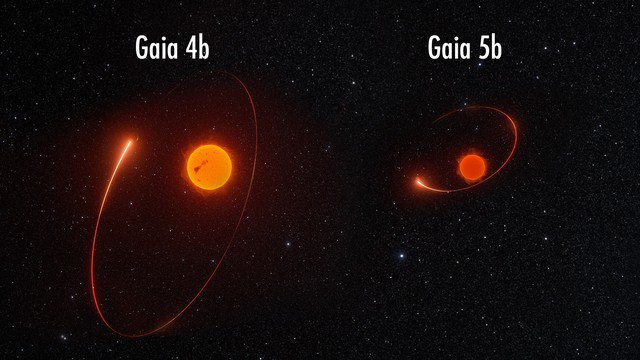Superplanet 3,752 times heavier than Earth discovered
Analyzing data from the European Space Agency's (ESA) Gaia spacecraft, scientists have discovered a planet named Gaia-4b and a brown dwarf named Gaia-5b orbiting two dwarf stars.
They are all incredibly strange and great worlds.

Graphic depicting planet Gaia-4b and brown dwarf Gaia-5b orbiting two orange and red dwarf stars - Photo: ESA
According to a paper published in the Astronomical Journal, Gaia-4b is a "super-Jupiter" planet, a gas planet similar to Jupiter but much larger. Measurements show that its mass is 11.8 times that of Jupiter, or 3,752 times that of Earth.
It orbits a red dwarf or orange dwarf star, called Gaia-4, and is located about 244 light-years from Earth.
Sci-News quoted Dr. Guðmundur Stefánsson from the University of Amsterdam (Netherlands), a member of the research team, that this planet has an orbital period of 571 days, meaning it orbits quite far from its parent star and is relatively cold.
Gaia-4b is also one of the first exoplanets discovered using astrophotometric techniques and is one of the largest known planets orbiting a low-mass star.
Another interesting discovery is the brown dwarf Gaia-5b, which orbits the red dwarf star Gaia-5, about 134 light-years from our planet.
Brown dwarfs are some of the weirdest objects in the universe. They typically have a mass greater than 13 times that of Jupiter, are too large to be planets, and are not typically born from the protoplanetary disk of any star.
However, Gaia-5b — like other brown dwarfs — is still too small to sustain nuclear fusion in its core, which would qualify it as a star.
It is therefore considered a "failed star" or "high-class planet" and is probably a companion to Gaia-5, rather than a "child" of this red dwarf star.
In this case, scientists calculated the mass of this half-star, half-planet object to be about 21 times that of Jupiter, or 6,678 times that of Earth.
You should read it
- Discover a new dwarf planet about the size of a Pluto in the Solar System
- New discovery of life on planet GJ 1132b, 'Super Earth' is 39 light-years away
- Discovering the planet has an orbit of 4.5 hours, where people can live 150,000 years
- Strange white dwarf discovered, split by hydrogen and helium gas
- How big is the solar system?
- Discovering another 'super Earth' can appear to live only 21 light-years away
- Why have scientists found Proxima b - '2nd Earth' until now?
- Unique new species of squid, super small 1cm, hunts by sitting still
- The Hubble Telescope discovered a pair of small dwarf galaxies containing many interesting features
- Space Science: The order of 8 (or 9) planets in the Solar System
- James Webb captured the most difficult to find object in the universe, 2,000 light years away
- Hot Jupiter is being torn apart by its host star
Maybe you are interested
15 traditional customs during the traditional Vietnamese New Year Admire the iPhone 11 Pro titanium inspired by the Tesla Cybertruck 'supercar', priced at 120 million Xiaomi Mi Band 5 will have a bigger screen, supporting touchless payment worldwide [Compare] Mi Band 2 and Mi Band 3 - Better design, more features 7 steps to successfully overcome Windows network 5 steps to troubleshoot Wi-Fi network problems
